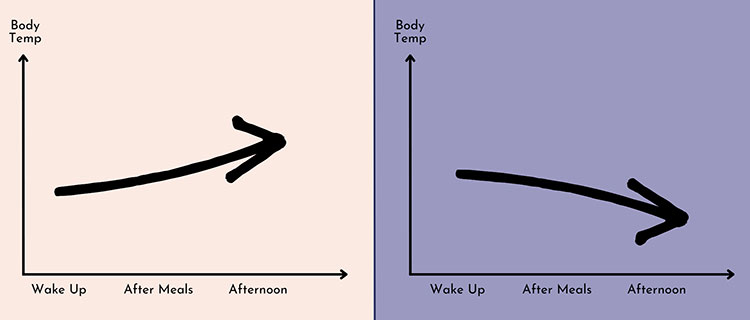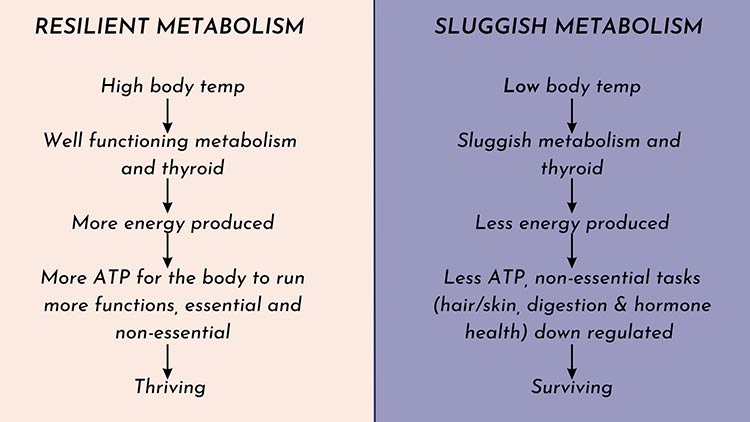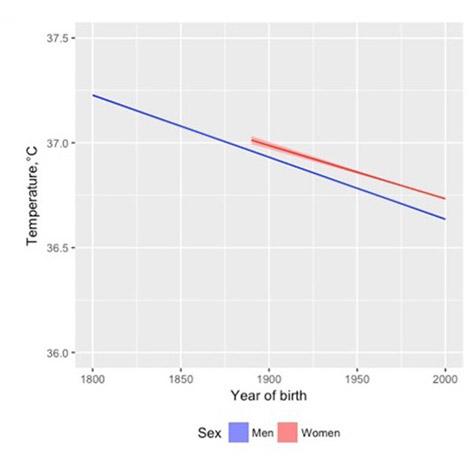One of the easiest ways to assess your metabolic health at home is a simple body temperature measurement. Body temperature is a sign of how well your body is creating and utilizing energy. So, a lower body temperature is a sign that our body is not producing a lot of energy (meaning, hindered metabolic function).
Measuring my body temperature for the first time five years ago was my lightbulb moment when I finally accepted and realized that my previous restrictive lifestyle (keto, fasting, and carnivore) was no longer serving me.
The oral thermometer reading was 96.5 degrees Fahrenheit (F), with a pulse in the 50-60 bpm range.
These readings screamed YOU ARE IN SURVIVAL MODE and are NOT thriving. Some of the symptoms I was experiencing while in this hypothyroid, low energy state (confirmed by my low body temperature) included cold hands and feet, hair thinning, digestion problems, limited food tolerance (had a very limited list of foods I was able to consume), and dwindling energy levels.
A low body temperature is a sign that what you are doing now is not optimal. But do not worry, this can change and be improved. But you may need to make some dietary and lifestyle changes.
Why Body Temperature and Pulse Measurements Provide Insight Into Metabolic Health
You do not run on thin air — as every function in your body requires energy. And this energy is largely obtained by the food we consume (of course other factors like light and sun exposure matter as well!) But electrons come in through the food we consume, and the goal is to get those electrons into the mitochondria through the electron transport chain all the way to the final electron acceptor, oxygen, in order to make the energy molecule that fuels life: ATP.
A thriving body with a strong metabolism generates plenty of energy so that all functions of the body run smoothly. So, the less ATP we generate, the less energy your body has to function and non-essential tasks are down regulated.
A high metabolic rate comes with a number of perks — you can eat more calories and maintain your weight, have more energy in life, have a better body composition, digest food better, eat a wider variety of foods, have great digestion and poops, sleep better, and live an overall higher quality life.
With better energy production, you thrive, instead of just survive. A byproduct of energy production is heat. So, a simple way to assess your metabolic health at home is body temperature and pulse measurements taken throughout the day.

So, higher body temperatures = higher metabolic rate since we are producing a lot of energy and generating heat as a byproduct.
Our body temperature is on a circadian clock. In a thriving and resilient body, your waking temperature should be high 97s/low 98s F, and pulse measurements should be in the 70-90/95 BPM range.
Your body temperature should then slowly increase after each meal, reaching 98.6 deg F mid-day or early afternoon. Body temp will then slowly decline as we get closer to bedtime. Pulse measurements throughout the day should be in the 70-95 BPM range.
Why Take Multiple Body Temperature Measurements?

When assessing metabolic health, it is important to take measurements throughout the day, as stress hormones can keep your morning body temperature high. So, someone living on stress hormones can have a high waking temp that lowers after breakfast (which is not a sign of a strong metabolism, as we want to see the body temperature rise, a sign we are using food to produce energy). As explained by the late Ray Peat, a biologist and thyroid expert:
“If the night-time stress is very high, the adrenaline will still be high until breakfast, increasing both temperature and pulse rate. The cortisol stimulates the breakdown of muscle tissue and its conversion to energy, so it is thermogenic, for some of the reasons that food is thermogenic.
After eating breakfast, the cortisol (and adrenaline, if it stayed high despite the increased cortisol) will start returning to a more normal, lower level, as the blood sugar is sustained by food, instead of by the stress hormones.
In some hypothyroid people, this is a good time to measure the temperature and pulse rate. In a normal person, booth temperature and pulse rate rise after breakfast, but in very hypothyroid people either, or both, might fall.”
A drop in body temp after a meal shows that the food we consumed is lowering our stress (which is of course a good thing!), but it’s not necessarily adding to our metabolic energy reserves. A metabolically stimulating meal should increase heat (and thus, energy) production.
So, ideally your body temperature measurements should look like the pattern on the left. The pattern on the right is a sign of a sluggish thyroid and metabolic system, and high stress hormones.

Why Take Pulse Measurements?
Including pulse measurements is optional, but it can help you separate the effect of stress hormones or environmental factors and better assess metabolic health. Body temperatures can be influenced by a number of things besides thyroid, for example:
- Sleeping with heating blankets
- Living in a hot climate
Neither are bad, but both can make it easier for the body to regulate your temperature (despite having a hindered metabolism). Someone running on stress hormones can also have artificially elevated body temperatures (as discussed in the Peat quote above), especially first thing in the morning.
Thus, including the pulse rate measurement helps to interpret the temperature readings and provide more nuance. Because a high body temperature with a very low pulse is not a sign of a strong metabolism. Your pulse rate is reflective of the amount of nutrients and energy delivered to cells throughout the body (and this delivery is vital for proper ATP production!)
Despite popular belief, while a low heart rate may come with a super fit body, it is not always a sign of good health and is a sign of a lowered metabolism. With a low pulse (<60 bpm), the athlete’s body is becoming more efficient, using less energy to perform the same amount of work.
While this is helpful for the athletic event, this will come with negative effects in the long run like increased rates of aging, lowered libido, hindered digestion and other consequences of a lower metabolic rate. We of course do not want high pulse readings but staying in the 70-90/95 BPM range is ideal.
You can separate the effect of your stress hormones from your thyroid function by measuring your body temperature throughout the day and (optional) including the pulse rate.
Maintaining a high body temperature is also vital for optimal function of various organ systems throughout the body. A body temperature of 98.6 degrees F is the optimal temperature at which the systems in the human body function.1
Why? Enzymatic function depends on temperature. And every loss of optimal enzyme activity means a loss of functionality for the respective organ system. A drop of only 1.8 degrees F can result in a loss of approximately 50% of enzymatic activity.
Professor Hiromi Shinya, Ph.D., (Albert Einstein College of Medicine, NY, USA) demonstrated that lowering the body temperature by only 0.9° results in a 30% decline in enzyme and immune activity. He also discovered that cancer cells can multiply much faster at 95°F than at 98.6°F. The conclusion from his studies:2
“Humans with low body temps have decreased immunity, suffer circulation disorders, have increased genetic changes and thus an increased cancer risk.”
As your core body temperature falls, overall body function declines.3

Why Are Body Temperatures Low?
Lower body temperatures may be common these days, but it is not normal. Humans used to have an average body temperature of 98.6 deg F,4 but this temperature measurement has been on a steady decline5 while obesity rates have been on a steady rise.
As metabolic rates go down, weight gain rises as less energy is burned off as heat and more energy is stored. There are a number of reasons for this decline in body temperature (and metabolic rates) including (but not limited to):
|
Environmental pollutants and toxins like glyphosate |
Xenoestrogens |
|
Under-eating and constant restrict-binge cycles |
Low-carb diets |
|
High stress levels |
Increase in PUFA (polyunsaturated fatty acids) consumption |

It’s Kind of Like Squirrels
Squirrels and other mammals like bears and groundhogs are hibernating animals. Hibernation involves lowered body temperatures and slowed metabolic rates so that an animal can survive the winter (or adverse weather conditions) without eating. Non-essential tasks are down-regulated so that the animal can conserve energy.
Multiple studies have shown that hibernating animals require significant PUFA in their diets to fully enter hibernation.6,7,8,9,10 This is very well documented in the literature!
“Patterns of hibernation and daily torpor are influenced by the composition of dietary fats. Heterothermic mammals fed diets containing plant oils that are rich in UFA and PUFA have longer torpor bouts, lower Tb [body temperature] and lower MR [metabolic rates] during torpor than individuals fed diets containing fats that are rich in SFA.” Geiser et al., 199411
What do squirrels eat a TON of in the fall to get ready to hibernate in the winter? PUFA-rich nuts. Now, it is very advantageous for the survival of hibernating animals for them to fully enter hibernation. But it is NOT advantageous for humans to enter a hibernation-like state. The result = non-essential tasks are downregulated, and you gain weight on lower and lower calories.
Metabolism-Focused Health
If you currently have low body temperature measurements, all hope is not lost. But you likely need to make dietary and lifestyle changes so that you can THRIVE not just survive.
Utilizing simple body temperature measurements at home can be a great tool to see if dietary or lifestyle changes you make help boost metabolic rate (and thus raise body temperature). As your body temperature rises, your symptoms will reduce as more and more as “non-essential tasks” are upregulated again (because your body has the energy to spend!) So how can you improve body temperature measurements?
“Keeping the metabolic rate up is the main thing, and there are lots of ways to do it.” Ray Peat Ph.D.
There is no single cookie-cutter approach as we all come from different restrictive backgrounds. But here are a few tips to get started (using temperature measurements to guide you):
|
Eat enough calories for your needs (you will not thrive at 1,600 calories) |
Reduce PUFA consumption as much as you can |
|
Eat carbs that work well for you |
Strength train to build muscle |
|
Lower stress in your life where you can |
Pursue JOY and creation |
|
Stop choosing restrictive dietary pathways like excessive fasting or low-carb diets. While there may be short term benefits to restriction, they almost always come at a long-term metabolic cost (which is hard to see in the short term) |
To Learn More, Join Rooted in Resilience
If you need some nutritional support and guidance, and are interested in learning more about improving your metabolism so that you can eat more calories, eat food you enjoy, lose weight, and feel great, my sister and I teach you exactly how to do this in our course, Rooted in Resilience.
We have both been through it all: keto, carnivore, fasting, dairy free, vegan, plant-based, gluten-free, AIP and more. Our course provides over 10 years of experience and research packed into one place.
We help you leave behind all the restrictive diets, fear, and confusion around food. We empower you to become your best resource and start living your best life with the energy and confidence to follow your dreams, lose weight, and be confident in your health again.
“After one month since starting Rooted in Resilience my body temperature is now 98.6 deg F!” — Valerie
Learn more about Rooted in Resilience here.
About the Author
Ashley Armstrong is the cofounder of Angel Acres Egg Co., which specializes in low-PUFA (polyunsaturated fat) eggs, and the Nourish Cooperative, which ships low-PUFA pork, beef, cheese, A2 dairy and traditional sourdough to all 50 states. Waitlists will reopen shortly.
Article imported via RSS feed from Mercola.com
RSS Article Source: https://articles.mercola.com/sites/articles/archive/2024/04/16/how-to-assess-metabolic-health.aspx



